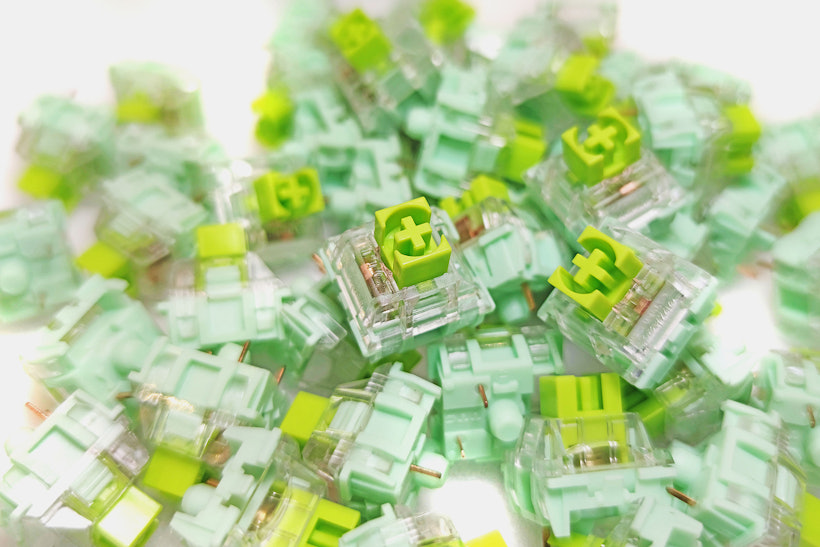Mechanical Switches Progress ( includes suggestions for choice )
The mechanical keyboard uses mechanical switches instead of membrane switches, which results in more noticeable tactile feedback and longer lifespan. The most important component of a mechanical keyboard is the mechanical switch, and there are many different types that vary in feel, response speed, and sound. In this article, we'll look at the history of mechanical switches, the different types available, who they're best suited for, and highlight some of the most representative switches.

(picture from TiKeBang)
Mechanical switches were first used in IBM's PC/AT keyboard in the 1980s, and the earliest switches were orange ALPS switches and black Cherry switches, which differed in sound and feedback. Over time, more types of switches have emerged, and today there are four main types: linear switches, tactile switches, clicky switches, and silent switches.

(picture from Wikipedia)
1.Linear Switch
The Linear Switch is a type of switch without an obvious tactile bump, offering no resistance or feedback when pressing down the key. It is suitable for gamers and fast typists who require high responsiveness and sensitivity in their keyboard. However, since it lacks tactile feedback, it may not be the best option for tasks that require precise positioning. The Linear Switch has a smooth and linear feel, providing a "bottom-out" sensation when the key is fully pressed down. A common type of Linear Switch is the Red switch, which has a spring weight of 45g.

(picture from DROP)
2.Tactile Switch
The Tactile Switch is a type of switch with a noticeable tactile bump, offering resistance and feedback when pressing down the key. It is suitable for typists or people who use the keyboard for extended periods, as it provides a more comfortable and satisfying typing experience. The Tactile Switch provides a tactile feedback or "click" when the key is pressed down, allowing users to feel the actuation point. A common type of Tactile Switch is the Brown switch, which has a spring weight of 45g.

(picture from DROP)
3.Clicky Switch
The Clicky Switch is a type of switch with an audible and tactile bump, producing a distinct "click" sound when the key is pressed down. It is suitable for people who require precise positioning and a more pronounced tactile and auditory feedback, such as coders or text editors. However, due to its audible click, it may not be suitable for environments where noise is an issue. A common type of Clicky Switch is the Cherry MX Blue switch, which has a spring weight of 50g.

(picture from DROP)
4.Silent Switch
As mechanical keyboards become more popular, some users may find the noise level of the keyboard to be disruptive. The Silent Switch is a type of switch specifically designed to reduce the noise and vibration when pressing down the key. It is suitable for people who need to use the keyboard in a quiet environment, such as in a public place or at night. Although the Silent Switch reduces the sound and vibration, it still provides a similar tactile and linear feedback as the Linear Switch. A common type of Silent Switch is the Cherry MX Silent switch or Kailh Silent switch, which has a spring weight of 45g.

(picture from DROP)
Suitable User Groups:
Different types of mechanical keyboard switches are suitable for different user groups. For example, linear switches are suitable for those who require quick response and high-speed typing, while tactile switches are suitable for those who need to use the keyboard and type for long periods. Clicky switches are suitable for those who need more pronounced feedback and precise positioning, while silent switches are suitable for those who use the keyboard in quiet environments.

Representative Mechanical Keyboard Switches:
Here are some representative mechanical keyboard switches:
Cherry MX series: one of the world's most famous mechanical keyboard switch brands, offering various types of switches, such as MX Red, MX Brown, and MX Blue.

(picture from DROP)
Kailh series: Kailh is another well-known manufacturer of mechanical keyboard switches. Its BOX series switches use a new switch design, making the keys more durable and less susceptible to dust and water damage.

(picture from DROP)
Gateron series: Gateron is a Chinese manufacturer of mechanical keyboard switches. Its switches are very similar to Cherry MX switches, but are relatively cheaper and have some modification potential.

(picture from DROP)
KTT series: a linear switch introduced by Kailh, similar to Cherry MX Red, with a relatively stable keystroke force. The KTT switch uses Kailh's independently developed BOX packaging structure, which has better dust-proof, waterproof, and durability properties than traditional packaging structures. The KTT switch also uses a metal spring design, which provides a longer lifespan and more stable feel. The spring strength of the KTT switch is generally 50g.

TTC series: a light-touch switch introduced by TTC, similar to Cherry MX Brown, with obvious tactile feedback and "click" feeling. The TTC switch uses TTC's independently developed packaging structure, which has better stability and smoother keystroke feel than traditional packaging structures. The spring strength of the TTC switch is generally 45g.

(picture from DROP)
The prices of KTT and TTC switches are relatively affordable compared to other switches, making them very suitable for users who have certain requirements for keyboard performance but don't want to spend too much money.
Overall, there are many types of mechanical keyboard switches, each with its unique characteristics and advantages and disadvantages. Choosing the right mechanical keyboard switch requires considering your own usage needs, such as typing volume, typing environment, and required feedback type, and trying different brands and types of mechanical keyboards to find the switch that best suits you.
Among mechanical keyboard enthusiasts, there are also some people who choose to assemble their own keyboards and customize their switches. Customizing switches allows users to choose different switches and keycaps according to their needs and preferences, and personalize their keyboards through various modifications to achieve their ideal keyboard experience.










